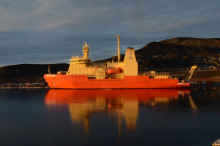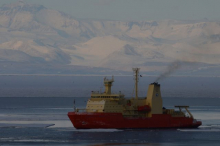High Arctic Change 2011
What Are They Doing?
The Svalbard Archipelago has an arctic climate and is home to several large bodies of ice called glaciers. There are alpine glaciers in the mountains, and also tidewater glaciers that end in long narrow bodies of seawater called fjords. For the past nearly 10,000 years, the glaciers of this region have been receding and most recently there has been a regional reduction in sea ice. The region is ideal for the study of past climate because the arctic is sensitive to changes in climate and several different types of measurements on and around glaciers can be conducted here.
The research team, which included undergraduate geoscience students participating in the Research Experiences for Undergraduates Program, traveled to Svalbard to investigate how climate change affects sediment transport and deposition associated with the tidewater glaciers, icebergs, meltwater streams, and marine currents. Tidewater glaciers are among the fastest changing systems in the Arctic, offering the team the opportunity to monitor rapidly changing and dynamic systems.
To conduct their research, they sampled ice from Svalbard glaciers and icebergs and studied the concentration of rocks and sediments. They also studied the sediments on the glacial fjord sea bed to look at where sediment from the glacier was being transported and deposited in the past. The oceanography of the fjord waters in front of the ice margins were also studied by the students. The team also utilized aerial photographs and GPS mapping to determine the position of the glacier and its rate of retreat. Using this data and more, the team helped determine what relationships exist between current sedimentation, glaciers, oceans, and weather data. Being better able to predict how glacial systems react to climate change helps scientists better understand their contribution to sea level rise.









